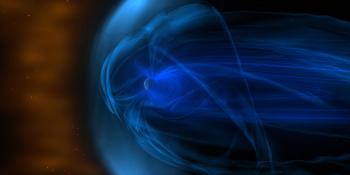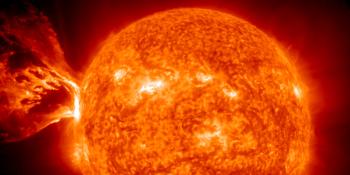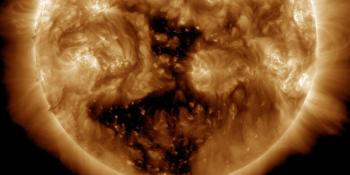Viewing archive of Saturday, 15 April 2023
Geophysical report
Solar and Geophysical Activity Summary 2023 Apr 15 0245 UTCPrepared by the NOAA © SWPC and processed by SpaceWeatherLive.com
Joint USAF/NOAA Solar and Geophysical Activity Summary
SGAS Number 105 Issued at 0245Z on 15 Apr 2023 This report is compiled from data received at SWO on 14 AprA. Energetic Events
Begin Max End Rgn Loc Xray Op 245MHz 10cm Sweep 0849 0849 0849 120 1012 1012 1013 250 1155 1155 1155 110 1237 1237 1237 120 1610 1618 1625 3282 M1.1 1727 1727 1727 100 1811 1811 1811 110 1836 1836 1836 100 2039 2045 2051 3282 C6.2 110 2318 2327 2331 3282 N11E54 M1.5 1n
B. Proton Events
None.
C. Geomagnetic Activity Summary
The geomagnetic field was quiet to
unsettled.
D. Stratwarm
Not available
E. Daily Indices: (real-time preliminary/estimated values)
10 cm 171 SSN 153 Afr/Ap 010/007 X-ray Background C1.5 Daily Proton Fluence (flux accumulation over 24 hrs) GT 1 MeV 3.5e+04 GT 10 MeV 2.3e+04 p/(cm2-ster-day) (GOES-16 satellite synchronous orbit W75 degrees) Daily Electron Fluence GT 2 MeV 1.60e+06 e/(cm2-ster-day) (GOES-16 satellite synchronous orbit W75 degrees) 3 Hour K-indices Boulder 1 1 2 2 3 3 1 1 Planetary 1 0 1 2 3 2 1 2
F. Comments
None.
All times in UTC
Latest news
Latest forum messages
AR 4055 121Ask your obscure/"stupid" space weather questions. 377Growth of Cycle 25 834Filaments and prominences 114Space Weather Memes 700
More topicsSupport SpaceWeatherLive.com!
A lot of people come to SpaceWeatherLive to follow the Sun's activity or if there is aurora to be seen, but with more traffic comes higher server costs. Consider a donation if you enjoy SpaceWeatherLive so we can keep the website online!

Space weather facts
| Last X-flare | 2025/03/28 | X1.1 |
| Last M-flare | 2025/04/22 | M1.3 |
| Last geomagnetic storm | 2025/04/21 | Kp5+ (G1) |
| Spotless days | |
|---|---|
| Last spotless day | 2022/06/08 |
| Monthly mean Sunspot Number | |
|---|---|
| March 2025 | 134.2 -20.4 |
| April 2025 | 122.8 -11.4 |
| Last 30 days | 117.7 -15.6 |


